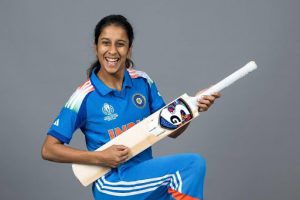Under the searing floodlights of DY Patil Stadium, as the Indian tricolour shimmered against the night sky, one catch changed everything.
Harmanpreet Kaur’s hands rose to the heavens, and so did a nation.
When that ball nestled safely into her palms, the crowd erupted, but the deeper roar was of something far greater than victory.
This was not just a trophy lifted.
This was a ceiling shattered.
A Win Years in the Making, and Centuries in Waiting
For the first time in cricketing history, India’s women stood on the podium of the world, not as underdogs, not as symbols of hope, but as champions.
And behind that glittering moment of glory lay a decision taken quietly in a BCCI boardroom three years earlier, a decision that dared to say “She deserves the same.”
In October 2022, the Board of Control for Cricket in India (BCCI) made a move that would redefine not just sport, but the spirit of fairness itself.
They introduced pay parity between India’s men’s and women’s cricketers, a step so audacious, so ahead of its time, that it sent shockwaves through the sporting world.
Many scoffed.
They said women’s cricket hadn’t “earned it.”
That sponsorships, viewership, and ticket sales couldn’t justify equal pay.
But where cynics saw risk, the BCCI saw revolution.
And three years later, the result gleamed in gold.
When Equality Becomes a Strategy, Not a Slogan
As the world watched Harmanpreet’s team script history, one truth became undeniable, equality pays off.
Not just morally, but measurably.
The BCCI’s policy wasn’t a feel-good gesture; it was a business decision built on belief.
Secretary Jay Shah’s celebratory message captured that vision perfectly:
“The grit, resolve and skill of the Indian women have inspired a nation. But their success is also built on bold policies — pay parity, better facilities, the WPL, and a coaching revolution.”
This wasn’t luck. It was leadership.
Behind those match-winning innings and death-overs heroics was an ecosystem, planned, funded, and fiercely nurtured to give women not sympathy, but structure.
The Women’s Premier League: Where Fire Was Forged
When the Women’s Premier League (WPL) launched, it did more than entertain, it empowered.
For the first time, Indian players shared the field with the world’s best week after week, growing under pressure, sharpening their instincts, and learning that they belonged on the biggest stage.
The WPL didn’t just create athletes. It created professionals, women who saw cricket not as a passion that needed permission, but as a full-time career built on dignity and equal opportunity.
Equal Pay Changed the Game — and the Mindset
Pay parity wasn’t just about the paycheck. It was about psychology.
When India’s women knew their time, talent, and toil were valued equally, something shifted within.
No longer did they juggle second jobs or sponsorship anxieties.
They could dream, fully, fiercely, and fearlessly.
And that confidence translated into performance.
Every boundary Smriti Mandhana struck, every wicket Deepti Sharma claimed, echoed one unspoken message:
“We are not the future of the game. We are the game.”
Deepti Sharma: The Face of a New Era

On that unforgettable night, Deepti Sharma etched her name into cricketing eternity.
With 58 crucial runs and a spell of 5/39, she not only won India the final, she won herself a place in history as the first cricketer, male or female, to score 200+ runs and take 20+ wickets in a single World Cup edition.
Her journey embodies what equal pay made possible — focus without fear, ambition without apology.
When opportunity meets equality, excellence is inevitable.
Smriti Mandhana: The Calm, The Class, The Catalyst

At the other end, Smriti Mandhana’s bat spoke with the authority of legacy and the grace of leadership.
Her record-breaking campaign; surpassing Mithali Raj to become India’s most successful batter in Women’s World Cup history, wasn’t just about numbers.
It was about narrative.
About a generation of girls watching her and realising they don’t need to fit into anyone’s legacy.
They can build their own.
Jemimah Rodrigues: The Spark That Lit the Fire

And then there was Jemimah Rodrigues, the heart of this team, the pulse that never stopped believing.
Every time Jemimah walked out, there was a certain rhythm in her stride, a mix of Mumbai’s Street grit and pure joy for the game.
Her strokeplay in crunch moments, her electric energy on the field, and her infectious camaraderie kept India’s spirit alive even when the odds dipped.
But more than the runs she scored or the catches she took, Jemimah’s contribution was emotional, she became the team’s morale engine.
She reminded everyone that playing for India isn’t pressure, it’s privilege.
She is the bridge between the veterans and the fearless youngsters — the living proof that confidence, courage, and character are as important as talent.
Jemimah didn’t just play cricket.
She personified hope with a ponytail and purpose with a smile.
The Bigger Picture: What India Just Taught the World
For decades, women’s sports have been trapped in a loop of logic:
“Be commercially successful first, then we’ll talk equality.”
But India flipped the script.
The BCCI didn’t wait for record-breaking TRPs or packed stadiums to invest, they created them through belief.
And now, the results speak for themselves: a world title, record attendance, and a surge of pride that no price tag can measure.
What the U.S. Women’s Soccer Team fought through lawsuits and protests, India achieved through policy and conviction.
It’s a model that says: Don’t wait for women to prove their worth, empower them, and they will prove the world wrong.
From “Despite” to “Because”
For years, India’s female athletes succeeded despite the system.
This victory marks the dawn of a new era, one where women succeed because of it.
For every girl gripping a bat in a dusty gully, for every young woman who’s been told she’s “Too ambitious,” this isn’t just inspiration, it’s instruction.
You don’t need to ask for a seat at the table.
You can build your own.
A New Chapter for Indian Sport
As confetti rained over the DY Patil Stadium and the Indian women lifted their maiden World Cup trophy after defeating South Africa by 52 runs, the applause was not just for a team, it was for a transformation.
Equal pay didn’t just change their income.
It changed their outcomes.
The Final Word
This isn’t merely a story about cricket.
It’s a story about courage, of institutions that dared to invest, and women who dared to deliver.
It’s a story that reminds every federation, every sponsor, and every policymaker that when women are given equality, they don’t just participate, they dominate.
So, as the world rewrites its playbook, remember this:
India didn’t just win a World Cup.
It proved that when you level the field, women will raise the game.







